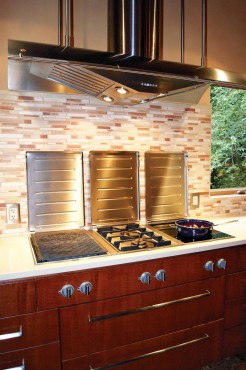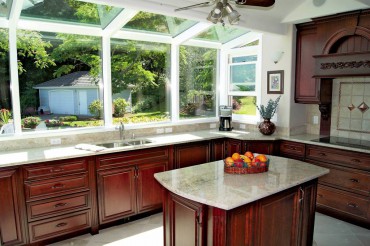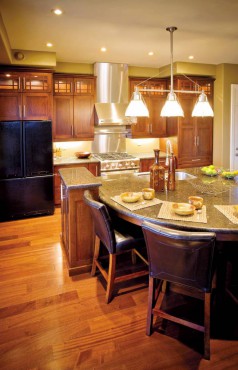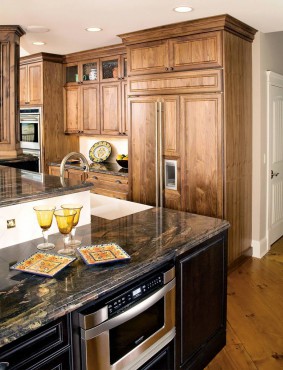
Despite the downturn in the national and local economy, remodeling of existing homes is on the rise. This is due, in part, to the fact that the average age of homes in our area is well over 30 years old, coupled with the trend that homeowners are shifting their focus from “trading up” to new construction homes to choosing to make the most of the home they already own.
Remodeling, for anyone who has experienced it, is both an art and a science. Therefore, if you want to make the most of your remodel investment (time and money) you may want to consider hiring a professional designer to help you. As with any professional service, there are many things to consider when hiring a professional designer.
 First, recognize that designers come in three primary flavors: colorists — designers who specialize in color consulting for all rooms of a home; interior designers (decorators) — designers who specialize in interior furnishings including window treatments, flooring, furniture, decorative accessories and color consulting; and kitchen and bath designers, who specialize in the design and material specification of kitchens and baths as well as other rooms such as home theatres, home offices, laundry rooms and outdoor kitchens and require knowledge of ventilation, electrical and plumbing systems as well as structural items such as foundations, framing and glazing. Designers from the later two categories may offer project management services, whereby they will assemble a team of professionals to execute every aspect of your project and oversee the installation of the entire project. So begin your search by seeking out designers who have experience with projects that match the scope of your project and your specific needs.
First, recognize that designers come in three primary flavors: colorists — designers who specialize in color consulting for all rooms of a home; interior designers (decorators) — designers who specialize in interior furnishings including window treatments, flooring, furniture, decorative accessories and color consulting; and kitchen and bath designers, who specialize in the design and material specification of kitchens and baths as well as other rooms such as home theatres, home offices, laundry rooms and outdoor kitchens and require knowledge of ventilation, electrical and plumbing systems as well as structural items such as foundations, framing and glazing. Designers from the later two categories may offer project management services, whereby they will assemble a team of professionals to execute every aspect of your project and oversee the installation of the entire project. So begin your search by seeking out designers who have experience with projects that match the scope of your project and your specific needs.

After consulting with friends and neighbors, the best place to turn to for referrals is professional trade associations that represent designers, such as the American Society of Interior Designers and the National Kitchen and Bath Association. Membership in both organizations is comprised of design and allied trade professionals. Both offer their members a variety of continuing education classes as well as other learning and certification opportunities. Members are expected to uphold the organization’s prescribed design standards as well as its code of ethics.
 The NKBA is also known for its trademarked annual Kitchen & Bath Industry Show (KBIS), which typically consists of 600,000 square feet of exhibition space occupied by approximately 900 vendors and attended by more than 50,000 professionals over a three-day period. (This year’s show was at Chicago’s McCormick Place April 16-18.)
The NKBA is also known for its trademarked annual Kitchen & Bath Industry Show (KBIS), which typically consists of 600,000 square feet of exhibition space occupied by approximately 900 vendors and attended by more than 50,000 professionals over a three-day period. (This year’s show was at Chicago’s McCormick Place April 16-18.)
Once you have generated a list of designers for consideration, review their websites or portfolios and determine whether they have a specific style and if that style appeals to you (note that some designers apply the client’s style or the home’s architectural style to the project). If so, request a list of their references (including allied trades and suppliers) and call them all.

Don’t assume that because your co-worker, sibling or neighbor thinks a particular designer is the cat’s meow that he or she will be a good fit for you and your project. Design services are a relationship business, therefore, to have a successful project you need to feel like you have a strong rapport with this person.
Ask the references some hard questions, such as:
- Were there any problems during the course of your project? If so, did the designer resolve these issues to your satisfaction?
- Do you feel like the designer was respectful of your desires and your budget?
- Did the designer demonstrate a good depth and breadth of current product knowledge?
- Were there aspects of this project that really stand out for you, such as creative use of space or color?
 Unlike doctors or architects, designers are not “licensed” in the state of Washington (nor in 46 of the 49 other states). However, this should not be an area of concern, as designers do not physically install the materials they specify. By the off-chance they have specified an inappropriate light or plumbing fixture, for example, then the licensed and bonded plumber, electrician or contractor should be able to bring this to their attention and rectify the situation. You should ask the designers if all the trades people they work with are licensed and bonded and if the designers carry the requisite insurance for the types of services they are offering.
Unlike doctors or architects, designers are not “licensed” in the state of Washington (nor in 46 of the 49 other states). However, this should not be an area of concern, as designers do not physically install the materials they specify. By the off-chance they have specified an inappropriate light or plumbing fixture, for example, then the licensed and bonded plumber, electrician or contractor should be able to bring this to their attention and rectify the situation. You should ask the designers if all the trades people they work with are licensed and bonded and if the designers carry the requisite insurance for the types of services they are offering.
How many years of design experience do the prospective designer have, what is their educational background and do they possess any professional certifications? Note that experience can be a two-edge sword. Experience is good but only if it is supported by continuing education and professional certifications. Continuing education, such as participation in conferences, webinars, relative course work as well as professional designations, is indicative of professionals who consistently invest in their career as a means of providing their clients with knowledge of the most current trends and codes. The design-build industry is very dynamic and improving every day. A designer with many years of experience but no recent education may have difficulty developing fresh designs and can fail to bring emerging trends as well as the most current products and technologies to the proverbial table.

When meeting with a perspective designer for the first time in your home, note how well he or she listens to your ideas and needs. Do you get a sense of connectedness with the designer? This is probably the most important variable in the selection process.
Additionally, establish if the designer’s schedule meshes well with both your schedule and your time frame for the commencement and completion of your project. For example, is the designer willing to accommodate your schedule if you are only available for weekend meetings, does he or she have a client wait list, and how many other projects will there be under contract at the same time as yours? Lastly, be prepared to compensate the designer for time spent on the initial consultation. Some designers will give 30 to 60 minutes gratis but after that the meter goes on and for a good reason — the professional will be transferring valuable insights about your home and your project to you and it is only right that there is compensation for that expertise.
Recognizing that you simply want to get your project done now, the aforementioned suggestions may seem like a large task list. But realize that a little bit of homework can lead you to the right professional for your project and that working with a professional designer will not only save you time and money, but can go a long way toward making your dreams a reality.
This article was first published in the Summer of 2010 print edition of the WestSound Magazine. Any discrepancies, omissions, or inclusions that seem incorrect are purely due to the age of this article. WestSound Magazine deemed this article useful and beneficial as a contribution to today's readership, and therefore is included in this site's online article archives. If you feel the content of this article is detrimental due to its age, please feel free to contact us to request removal or modification.




























